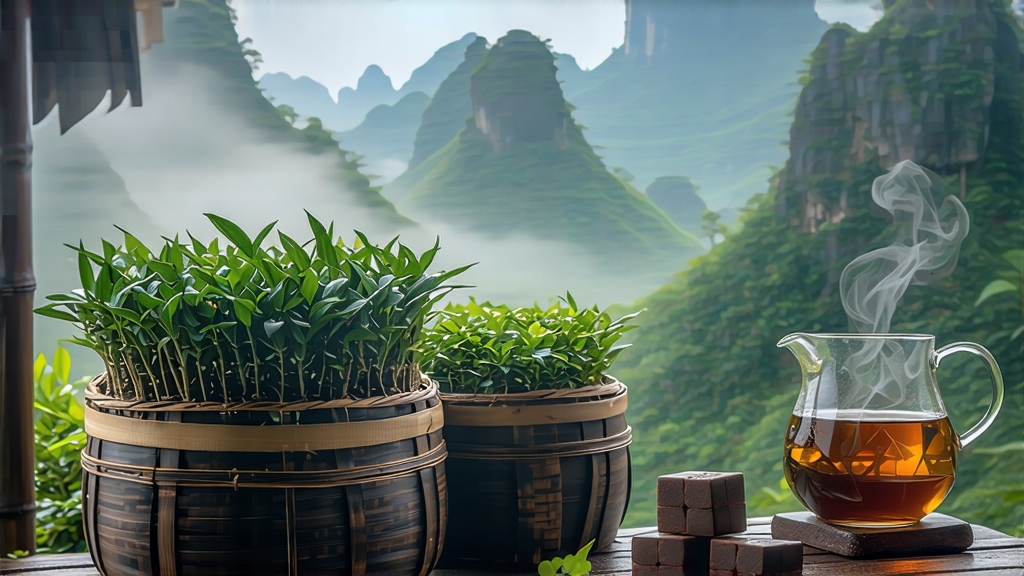
Tucked away in the humid, karst-pocked mountains of southern China’s Guangxi Zhuang Autonomous Region, Liu Bao (六堡茶) is the quietest celebrity of the dark-tea world. While Pu-erh grabs headlines and price records, Liu Bao has spent four centuries perfecting the art of subtlety, building a cult following among Cantonese tea merchants, Southeast Asian dockworkers, and, more recently, European sommeliers looking for the next frontier in fermented flavor. To understand Liu Bao is to listen to a slow, bass-note conversation between microbe, leaf, and time.
History: From Mountain Track to Maritime Silk Road
The name simply means “Six Forts,” referring to the six strategic stockades that once guarded the small county of Cangwu. During the Ming dynasty, imperial soldiers stationed there found that the local tea, pressed into bamboo baskets and strapped to mule saddles, mellowed during the humid march southward. By the Qing, Liu Bao was ballast in the holds of junks sailing for Singapore and Kuala Lumpur; the constant spray of salt water and tropical heat accelerated fermentation, turning the tea into a dark, soothing tonic that cooled sailors in equatorial ports. In 1801 the Jiaqing Emperor listed Liu Biao cha (an old spelling) as one of the 24 tribute teas, sealing its reputation from Guangzhou’s Thirteen Factories to the tea shops of Penang.
Micro-Terroirs within One Name
Today “Liu Bao” is a protected geographical indication, yet within the 2,000 km² production zone three micro-zones are whispered about by collectors:
- Tang Ping – high elevation, mineral-rich yellow soil; teas here develop a cooling menthol finish.
- He Ping – red clay slopes once planted with sweet olive trees; the flowers’ fallen petals lend a quiet honey note.
- Liu Dong – lowest altitude, warmest nights; microbes flourish, yielding the deepest betel-nut aroma prized in Malaysia.
Farmers further subdivide gardens by elevation band (shangshan, zhongshan, xiashan) and by the age of the tea grove; bushes propagated from air-layered cuttings in the 1950s are already considered “lao cong” (old bush), giving leaf that is thicker, waxier, and richer in aromatic precursors.
Craft: The Secret Life of 30,000 Microbes
Liu Bao belongs to the “wet-piled” or “wo dui” family, yet its protocol predates the 1973 Pu-erh analogue by centuries. After spring picking (one bud, three to four leaves), the leaf is carried in bamboo baskets to the primary factory where it receives three gentle roastings in woks heated to 80 °C—just enough to kill surface enzymes while preserving deep-seated microbes. The still-warm leaf is then piled 70 cm deep on raised bamboo platforms inside a room kept at 28 °C and 85 % relative humidity. A proprietary inoculum called “hua xiang” (flower starter) is sprinkled every 12 hours; this powder is simply last year’s best batch crushed and sifted, a living library of 30,000 bacterial and fungal strains dominated by Aspergillus niger, Blastobotrys adeninivorans, and a local yeast dubbed Candida liubaoensis. Over 18–25 days the pile is turned five times; temperature probes must never read above 55 °C, or the precious betel-nut note will flatten into wet earth. When the master smells dried longan and nutmeg, the pile is disassembled and sun-dried on bamboo mats for only 40 minutes—just enough surface dryness to trap the aroma inside. Finally the tea is steamed, pressed into 40 kg bamboo baskets lined with wild banana leaf, and moved to an above-ground “cave” built from limestone blocks where it will rest for a minimum of three years before release. In Malaysia some baskets remain in open-air godowns for decades, the tea slowly inhaling the scent of joss sticks and sea salt.
Aging Grammar: How Time Rewrites Flavor
Liu Bao ages differently from Pu-erh. Pu-erh’s dominant microbe, A. niger, oxidizes polyphenols into theaflavins, creating bright red infusions and camphor top notes. Liu Bao’s microbial consortium, enriched by the banana-leaf wrapper, prefers to cleave flavonoids into aglycones that read on the palate as dark chocolate, sand